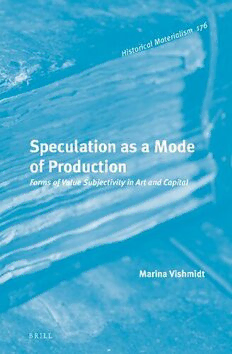
Speculation as a Mode of Production: Forms of Value Subjectivity in Art and Capital PDF
Preview Speculation as a Mode of Production: Forms of Value Subjectivity in Art and Capital
SpeculationasaModeofProduction Historical Materialism Book Series EditorialBoard SébastienBudgen(Paris) DavidBroder(Rome) SteveEdwards(London) JuanGrigera(London) MarcelvanderLinden(Amsterdam) PeterThomas(London) volume 176 Thetitlespublishedinthisseriesarelistedatbrill.com/hm Speculation as a Mode of Production Formsof ValueSubjectivityinArtandCapital By MarinaVishmidt LEIDEN | BOSTON LibraryofCongressCataloging-in-PublicationData Names:Vishmidt,Marina,author. Title:Speculationasamodeofproduction:formsofvaluesubjectivityinartand capital/byMarinaVishmidt. Description:Leiden;Boston,MA:Brill,[2018]|Series:Historicalmaterialismbook series,ISSN1570-1522;Volume176|Includesbibliographicalreferencesand index. Identifiers:LCCN2018041088(print)|LCCN2018045128(ebook)| ISBN9789004384774(ebook)|ISBN9789004291379(hardback:alk.paper) Subjects:LCSH:Art–Economicaspects.|Speculation.|Capitalproductivity.| Finance–Politicalaspects. Classification:LCC N8600(ebook)|LCC N8600 .V562018(print)| DDC706–dc23 LCrecordavailableathttps://lccn.loc.gov/2018041088 TypefacefortheLatin,Greek,andCyrillicscripts:“Brill”.Seeanddownload:brill.com/brill‑typeface. ISSN1570-1522 ISBN978-90-04-29137-9(hardback) ISBN978-90-04-38477-4(e-book) Copyright2019byKoninklijkeBrillNV,Leiden,TheNetherlands. KoninklijkeBrillNVincorporatestheimprintsBrill,BrillHes&DeGraaf,BrillNijhoff,BrillRodopi, BrillSense,HoteiPublishing,mentisVerlag,VerlagFerdinandSchöninghandWilhelmFinkVerlag. Allrightsreserved.Nopartofthispublicationmaybereproduced,translated,storedinaretrievalsystem, ortransmittedinanyformorbyanymeans,electronic,mechanical,photocopying,recordingorotherwise, withoutpriorwrittenpermissionfromthepublisher. AuthorizationtophotocopyitemsforinternalorpersonaluseisgrantedbyKoninklijkeBrillNVprovided thattheappropriatefeesarepaiddirectlytoTheCopyrightClearanceCenter,222RosewoodDrive, Suite910,Danvers,MA01923,USA.Feesaresubjecttochange. Thisbookisprintedonacid-freepaperandproducedinasustainablemanner. Contents Preface vii Acknowledgements xii Introduction:SpeculationasaModeofProductioninArtandCapital 1 1 Introduction 1 2 SpeculationasMethod 5 3 HowDoesArtSpeculate? 9 4 IsThereaSpeculativeModeofProduction? 11 5 ChapterSummaries 13 1 Speculation:theSubjectivityofRe-structuringandRe-structuring Subjectivity 28 1 SpeculationintheNegative 34 2 SpeculativeSubjects 41 3 FetishismandtheProductionofSubjectivity 49 4 SpeculationorRealSubsumption 53 5 ToHumanisCapital 59 6 HumanCapitalandArt 61 7 SpeculationandAbstractLabour:anAbstract 63 8 Self-Appreciation? 67 9 FromSelftoSpecies-Being 71 10 ValueEqualsZero 73 2 TopologiesofSpeculation:theTensesofArt,LabourandFinance 78 1 ‘Counterproductive’andAbstractLabour 86 2 AutonomyinGeneralisedSpeculation 93 3 SpeculationandContingency 98 4 Whatisan‘AbsoluteContingency’? 102 5 FuturesandtheFuture 105 6 ArtasCounterproductiveLabour 113 7 InvisibleLabour 118 8 VisibleFinance 122 9 Conclusion 124 vi contents 3 AestheticSpeculationsandAntagonisms 126 1 IsArtWorking? 135 2 RealSubsumption 146 3 NegativeComposition 153 4 TheSpecialistofNon-specialism 154 5 NegateHere 162 6 TheCritiqueofthePowerofJudgementandtheCritiqueofthe PowersofArt:KantianInterlude 166 4 WhateverIndicator:Indeterminacy,Judgement,andPuttingthe SpeculativetoWork 175 1 Introduction 175 2 TheNameofArt 177 3 ToBeDonewiththeJudgementofArt 182 4 Counter-artisticProduction 185 5 WhateverIndicator 188 6 ReproductivePotentiality 193 7 SubhumanCapital 197 8 ArtistPlacementGroup–IncidentalPerson,orNegationofthe Artist? 199 9 ExcursusonUse-Value 206 10 ArtisticCommunism–aSpeculativeGesture 209 11 Art–DepartureorDestination? 214 Conclusion:WhitherSpeculation? 217 1 OneMoreTimeifYouWouldbeUseless 219 2 TrajectoriesoftheGeneric 223 3 PrognosticCoda 228 Bibliography 231 Index 251 Preface Nineteenth-century English crafts entrepreneur and political organiser Wil- liamMorriswasknownforhisuntiringchampioningof artisanalproduction aspartandparcelof socialrevolution,andartfurnishedtheprototype.‘Art’, Morriswrote,‘istheexpressionof joyinlabourratherthananexclusivelux- ury’.Today,overacenturyafterthisresoundingproclamation,inatechnolo- gicalenvironmentthatitsauthorcouldscarcelyhavebeguntoimagine,this idea,thatartmightconstitute‘joyinlabour’,andthatitisthischaracteristic ofartspecificallythatdefinesitsimportancetoindustrialcivilisation,hasalso cometomeansomethingthatMorriswouldhavestruggledtorecognise.Take the artistic work of Christine Hill, which consists of reproducing the activit- ies and paraphernalia of small business. Hill both runs a small boutique in Berlin and thematises the processual aspects of this proprietorship as part of the enterprise, reflecting on an ‘outmoded’ but decisively back-in-vogue formofartisanaltradewhichbecomeseverlessdistinguishablefromtheeco- nomicprofileof thecontemporaryartist.Anotherartist,JeremyHutchinson, upends Morris’s rejection of industrial production by commissioning ‘erro- neous products’ from East Asian factories.The resulting objects, the form of whichHutchinsonleavestothediscretionof theworkerinquestion–some aremeticulouslydestroyed,otherswhimsicallyaltered–thenembodythelov- ing, artisanal, ‘concrete’ labour of factory operatives who otherwise have no control over their work. Finally,Theaster Gates – who once titled a show at theWhiteCube‘MyLaborisMyProtest’–hasforgedalucrativeandcritically vauntedcareerwhichhasmobilisedinterestandinvestmentinderelicthistor- icallyAfrican-AmericanareasofChicagothroughacomplexandperformative practiceinvolvingobject-making,advocacyandthephysicalrehabilitationof spaces,asortofbenignartist-run(ratherthanart-led)gentrification.LikeMor- ris,Gatesseemstoprovideaviewontobothanunalienatedformoflabourand a set of social arrangements in which it can be realised, a vision vouchsafed inbothcasesbytheavailabilityofprivatecapital.Whatcanallthesepractices besaidtoshare,howeverprovisionally?Theystraddleartisticandnon-artistic typesoflabour,gamblingonanartisticpracticereachingbeyondartbymeans ofart,foracriticalpurchaseorreal-worldeffectswherearthasnopre-existing claims.AsAdornohasnoted,theartworkmaybeaplenipotentiaryofaliber- atedfuture,butatthesametimethe‘basiclevelsofexperiencethatmotivate artarerelatedtothoseof theobjectiveworldfromwhichtheyrecoil’.1Thisis thecharacteristicgestureofspeculationasamodeofproduction. 1 Adorno2007a,p.7. viii preface Why ‘speculation as a mode of production’?The reason for choosing this formulationisthatitconjoinsthetwosensesof speculationtobedeveloped in what follows – the speculative practices of art, and financial speculation asanintensificationofcapital’sintrinsictendencyforfuture-orientedgrowth. Whilespeculativethoughtisaconstantfeatureof art,particularlyincritical practiceswhichrelatetotheconditionsof theirownproductionasmaterial, ‘financialspeculation’canbemorebroadlydefinedastheself-expanding,or self-valorising, dynamic of capital as such.This is the tendency that is high- lighted in value-form analysis – speculation as social form – rather than the specificsubsetoffinancecapitalwhichcanbenamedas‘thefinancialindustry’, althoughthismorespecificfocusisnotexcludedfrommyanalysis.Myprimary aim here will be to show how such speculation aligns itself with the ‘open- endedspeculation’ofthinkingandart,onlyforthisopennesstostabiliseitself onotherlevelsof thetotality.Thesearethelevelswheretechnicalandideo- logical instruments such as derivatives and ‘human capital’, no less than the intensifiedexploitationandprimitiveaccumulationtheymakepossible,apply. Hence‘speculationasamodeofproduction’referstotheopen-endedpro- cessesofartandconceptualthought,aswellastheoverdeterminedprocesses oftheincreaseofvalueincapitalism.Itmustbenotedthatthesetwotraject- oriesarehardlyasinsulatedfromoneanotherasthephrasingmightsuggest. Therecentperiodhasseenthesubjectivequalitiesofcreativity,flexibilityand innovationbecomeobjectivefactorsofworkplaceproductivity,whileobjective productivityitself shiftstotheindeterminacyandriskassociatedwith‘creat- ivefinancialinstruments’asthedominantmodeofcapitalaccumulation.What hasbeendiscussedinmanyquartersas‘financialisation’highlightstheestab- lishmentofthesespeculativeprocessesasthecorelogicofcapitalaccumula- tion.Thisisreflectedinthesocialfieldintheinstitutionalisationofspeculative processes(suchas‘risk’)ingovernance,workandwelfare.Theexploitationof risk (or risk-based exploitation) as the cornerstone of social reproduction in thisperiodcanbesubstantiatedthroughapanoplyof empiricalstudiesand critical analysis, but the concern here is to draw a parallel between contem- porary capital and contemporary art as they come to constitute the poles of a society structuredaroundspeculation, reflectedin social practicesranging fromsystemsofwelfareprovisiontotheconstitutionoftheselfandtheimage ofwork. The subjective experience of speculation becomes economically codified as ‘creativity’ in the neoliberal labour market. As a consequence, creativity becomes, paradoxically, a characteristic of abstract labour – the generic cat- egoryforthesocialinstitutionofwagelabourinacapitalistsociety,indifferent astocontent.Iwillarguethatsuchashiftheraldstheconversionofthehypo- preface ix statisedcreativityofartintoapre-eminentinstanceofspeculationasamode of production, since art becomes no longer just a commodity in the market oragratuitousactivitybutatoolof socialisationandre-valorisationof land, populationsandpoliticalentities.Itthustakesonanewinstrumentalityrelat- ive to the autonomy and heteronomy assigned to art by Marxist critics such as Theodor W. Adorno; albeit an instrumentality which speculates with the autonomyandfreeuniversalitybestoweduponartinanunfreesocietyinorder tomakeitsethicalclaims. Theprofoundstructuralanalogybetweenartandmoneyisthateachrepres- entsaninstanceof self-valorisingvalue,insofarasbotharesocialmediations which are anchored in a self-referential or reflexive circuit of valorisation – criticalvalueinartisgeneratedfromtransactionswithinitssemanticdomain, muchasinspeculativefinance(or‘fictitiouscapital’,inMarx’sterms)money generatesmoremoneythroughtransactionsinternaltofinancialmarkets.This homology,revealingbothartandmoneyasmarkedbythenebulousnessand reflexivityofvalueclaims,hasbeenpickedupbyartistswhocollideso-called ‘criticalvalue’with‘capitalvalue’inworksexploringthesocialandformalcor- respondencesbetweenworksofartandmoney.Butthediscussionofthissym- metryisintendedchieflytoilluminateanotherpoleofart’srelationtothereal abstraction of the capital relation, one which is constituted by the homolo- gies between art and a self-motivated and creative labour-force increasingly encouragedtoseeitself asaninvestment,i.e.,tomodelitself ontheendless productivityofcapitalratherthanlabour,andmorespecificallyonafinancial- isedcapitalwhichexpandsbymeansof(managed)risk. One aspect of this is the re-invention of labour as ‘human capital’, a shift whichservestoeliminatelabourasaseparateandpotentiallyantagonisticpole in the capital-labour relation. Labour also experiences itself as capital in its directrelationshiptothefinancialsystemthroughtheprivatisationof social reproduction.Thisisthesubsumptionof keypublicassetssuchaspensions, housingandeducationintocreditmarkets,orthetransformationofpublicpro- visionfoundedonsocialsolidarityintocommodifiedmarketassetsfoundedon self-investment.Thuswecanproposethatspeculationasamodeofproduction alsoimpliesabecoming-speculativeofreproduction.Thisiswhereartbecomes salient,asalreadynoted,initsabilitytoprojectformsofcommunityandsocial- ity,whetherideallyorparticipatively,thatpurporttore-socialisethesubjectof humancapitaland‘askquestions’intimesofpoliticalquiescence.Art’sability toaddimaginativevaluetoplacesandsituationsgivesanemancipatoryimago tolabourandmaterialconditionsgrownevermoreexploitative,opaqueand unalterable,andtoitssubjects,whoseekto‘addvalue’tothemselvesascre- ativecommoditiesinthelabourmarket(inperversecontinuitywithMarxian
